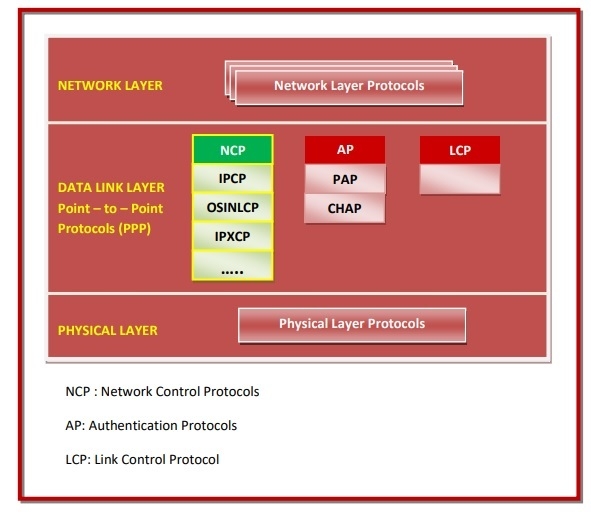
 Data Structure
Data Structure Networking
Networking RDBMS
RDBMS Operating System
Operating System Java
Java MS Excel
MS Excel iOS
iOS HTML
HTML CSS
CSS Android
Android Python
Python C Programming
C Programming C++
C++ C#
C# MongoDB
MongoDB MySQL
MySQL Javascript
Javascript PHP
PHPPhysics
Chemistry
Biology
Mathematics
English
Economics
Psychology
Social Studies
Fashion Studies
Legal Studies
- Selected Reading
- UPSC IAS Exams Notes
- Developer's Best Practices
- Questions and Answers
- Effective Resume Writing
- HR Interview Questions
- Computer Glossary
- Who is Who
Network Control Protocol (NCP)
Network Control Protocol (NCP) is a set of protocols forming a part of Point − to − Point Protocol (PPP). PPP is a data link layer protocol that is used to transmit multiprotocol data between two directly connected (point-to-point) computers. PPP is composed of link control protocol (LCP), authentication protocol (AP) and network control protocol (NCP). NCPs are used for negotiating the parameters and facilities for the network layer. For every higher-layer protocol supported by PPP, one NCP is there.
The following diagram illustrates the layer in which NCPs operate:

List of NCPs
Some of the NCPs are −
Internet Protocol Control Protocol (IPCP) − IPCP establishes and configures Internet Protocol (IP) over a PPP link. It configures the IP addresses in addition to enabling/disabling IP protocol modules on either end of the PPP link.
OSI Network Layer Control Protocol (OSINLCP) − The responsibilities of OSINLCP include configuring, enabling and disabling the OSI protocol modules on either end of the PPP link.
Internetwork Packet Exchange Control Protocol (IPXCP) − The responsibilities of OSINLCP include configuring, enabling and disabling the Internet Packet Exchange (IPX) modules on either end of the PPP link.
DECnet Phase IV Control Protocol (DNCP) − This is responsible for establishing and configuring Digital's DNA Phase IV Routing protocol (DECnet Phase IV) modules over PPP link.
NetBIOS Frames Control Protocol (NBFCP) − NetBIOS Frames (NBF) protocol is a non-routable network layer protocol. NBFCP is responsible for configuring, enabling, and disabling the NBF protocol modules on either ends of the PPP link.
IPv6 Control Protocol (IPV6CP) − IPV6CP configures the IPv6 addresses. Besides, it enables and disables IP protocol modules over PPP.

